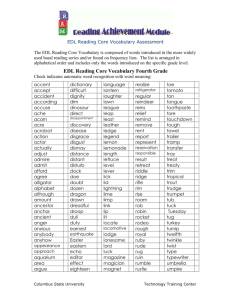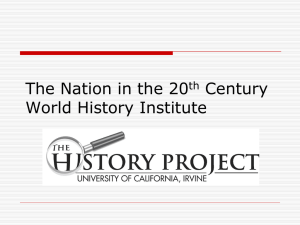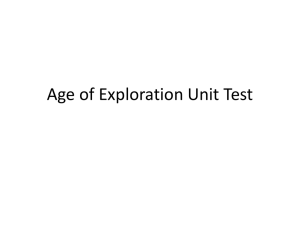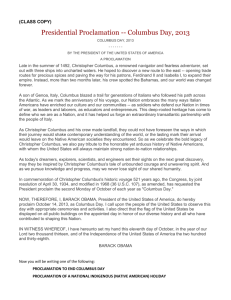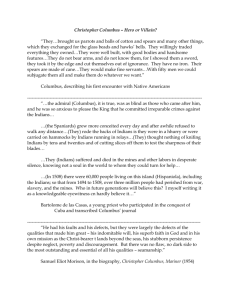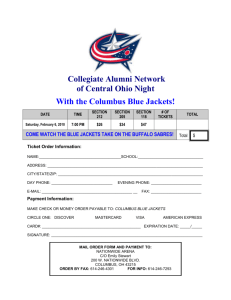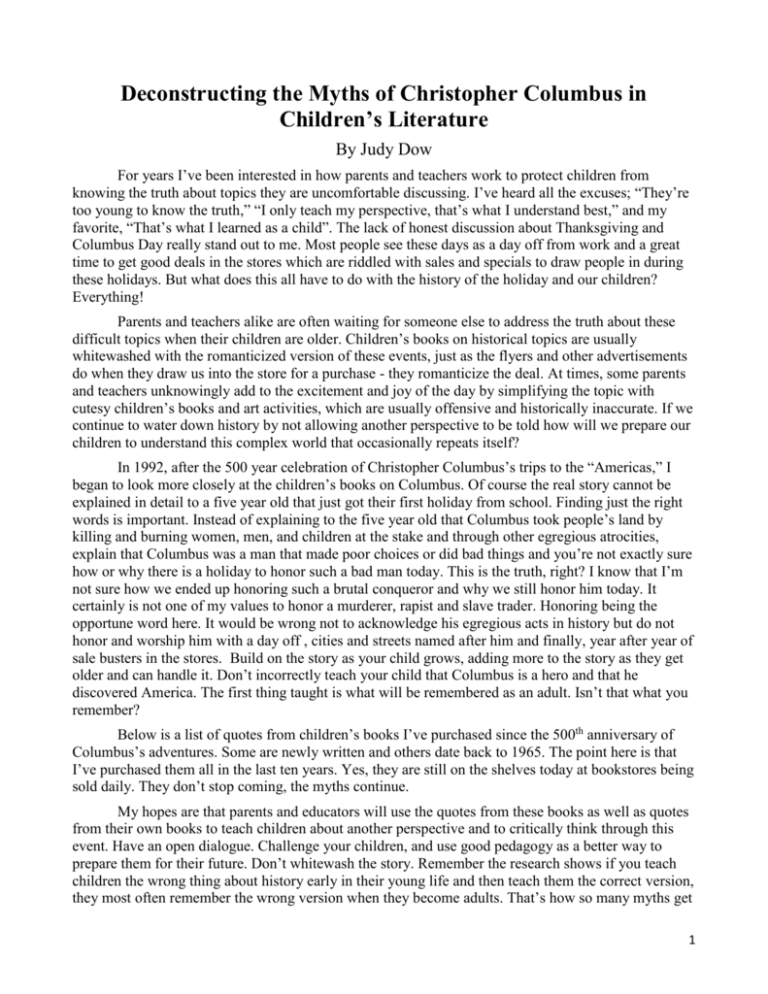
Deconstructing the Myths of Christopher Columbus in
Children’s Literature
By Judy Dow
For years I’ve been interested in how parents and teachers work to protect children from
knowing the truth about topics they are uncomfortable discussing. I’ve heard all the excuses; “They’re
too young to know the truth,” “I only teach my perspective, that’s what I understand best,” and my
favorite, “That’s what I learned as a child”. The lack of honest discussion about Thanksgiving and
Columbus Day really stand out to me. Most people see these days as a day off from work and a great
time to get good deals in the stores which are riddled with sales and specials to draw people in during
these holidays. But what does this all have to do with the history of the holiday and our children?
Everything!
Parents and teachers alike are often waiting for someone else to address the truth about these
difficult topics when their children are older. Children’s books on historical topics are usually
whitewashed with the romanticized version of these events, just as the flyers and other advertisements
do when they draw us into the store for a purchase - they romanticize the deal. At times, some parents
and teachers unknowingly add to the excitement and joy of the day by simplifying the topic with
cutesy children’s books and art activities, which are usually offensive and historically inaccurate. If we
continue to water down history by not allowing another perspective to be told how will we prepare our
children to understand this complex world that occasionally repeats itself?
In 1992, after the 500 year celebration of Christopher Columbus’s trips to the “Americas,” I
began to look more closely at the children’s books on Columbus. Of course the real story cannot be
explained in detail to a five year old that just got their first holiday from school. Finding just the right
words is important. Instead of explaining to the five year old that Columbus took people’s land by
killing and burning women, men, and children at the stake and through other egregious atrocities,
explain that Columbus was a man that made poor choices or did bad things and you’re not exactly sure
how or why there is a holiday to honor such a bad man today. This is the truth, right? I know that I’m
not sure how we ended up honoring such a brutal conqueror and why we still honor him today. It
certainly is not one of my values to honor a murderer, rapist and slave trader. Honoring being the
opportune word here. It would be wrong not to acknowledge his egregious acts in history but do not
honor and worship him with a day off , cities and streets named after him and finally, year after year of
sale busters in the stores. Build on the story as your child grows, adding more to the story as they get
older and can handle it. Don’t incorrectly teach your child that Columbus is a hero and that he
discovered America. The first thing taught is what will be remembered as an adult. Isn’t that what you
remember?
Below is a list of quotes from children’s books I’ve purchased since the 500th anniversary of
Columbus’s adventures. Some are newly written and others date back to 1965. The point here is that
I’ve purchased them all in the last ten years. Yes, they are still on the shelves today at bookstores being
sold daily. They don’t stop coming, the myths continue.
My hopes are that parents and educators will use the quotes from these books as well as quotes
from their own books to teach children about another perspective and to critically think through this
event. Have an open dialogue. Challenge your children, and use good pedagogy as a better way to
prepare them for their future. Don’t whitewash the story. Remember the research shows if you teach
children the wrong thing about history early in their young life and then teach them the correct version,
they most often remember the wrong version when they become adults. That’s how so many myths get
1
passed on from generation to generation. Use age appropriate language that will allow you to add to
the story each year, create a learning environment that allows the children to increase their education
about these atrocities as they grow, and do not perpetuate myths by continuing the retell the half-truth
story that you learned as a child.
Christopher Columbus wrote a rather detailed journal of his first voyage, which he immediately
gave to the royal court in Barcelona upon returning to Spain. Queen Isabela then ordered the journal to
be copied. This second copy was called the Barcelona copy. The Barcelona copy was given to
Columbus just before his second voyage. The original remained with the King and Queen and that
copy has been lost to time. Columbus retained the Barcelona copy until his death, at which time it was
passed on to his son Ferdinand, who used it to write a biography of Columbus in 1538.With the
original Columbus copy, and the Barcelona copy lost by the weight of time, what remains is
Ferdinand’s story first, written in Spanish, then translated to Italian, parts dismissed as fanciful and
other parts embellished. This publication, called Historie, has been used by historians for generations
as indirect evidence of the original voyage.
Here is a list of myths that show up in children’s literature time and time again; followed by
facts, with the source I used to state the fact;
1. Christopher Columbus discovered a New World.
“The New World- They went to the land. It was good to see the land. It was a new land. It was the
New World.” Leonard Discovers America by Gene Darby
“For the rest of his life, Columbus never knows how truly great his discovery is. He has really found a
new world- a world that no one in Europe knew about.” Christopher Columbus by Stephen Krenshky
“On October 12, 1492, Christopher Columbus landed in the New World for the First Time.” In Their
Own words Christopher Columbus by Peter and Connie Roop
“Native Americans lived in the New World long before European explorers arrived there.” Did
Christopher Columbus Really discover America? And Other Questions About… The New World by
Emma Carlson Berne
“All his life he was sure he had reached the Far East. He was sure he had reached the lands near China
and Japan and India. He never knew that he had found a whole new land instead.” Christopher
Columbus by Ann McGovern
“He proved to all that such a long sea journey was possible, and in doing so he opened up a new world
for all of Europe.” The discovery of the Americans by Betsy and Giulio Maestro
“When Christopher Columbus landed on San Salvador, his first landfall in the New World, on October
12, 1492”…. Encounter by Jane Yolen
“Leonard was ready to go. He was going with Christopher Columbus. He was going to find a new
world.” Leonard Discovers America by Gene Darby
“Christopher Columbus did not find gold; instead he found a whole new world.” Who Was Christopher
Columbus? By bonnie Bader
Fact for discussion
On September 3, 1492 Columbus wrote “Four tropic birds came to the ship, which is a very
clear sign of land, for so many birds of one sort together show that they are not straying about, having
2
lost themselves. Twice, saw two pelicans; many weeds” and on October 11, 1492 after seeing flocks of
birds and a green plant float by Columbus wrote in his journal; “on the verge of the defining moment
of discovery.” Christopher Columbus did discover a new world. New to him that is. There were
hundreds of thousands of people that already knew this “new” land existed. Columbus was an
uninvited guest to this land. To some people he is seen as a barbaric invader that only had gold,
Christianization and colonization on his agenda.
2. Christopher Columbus landed in America.
“Columbus had rediscovered the Americas, although he did not know it.” The Discovery of the
Americans by Betsy and Giulio Maestro
“He has really found a new world- a world that no one in Europe knew about. It is called America!”
Step into Reading Christopher Columbus by Stephen Krensky.
“But they had landed in America, the New World.” A picture book of Christopher Columbus by David
A. Adler
“Columbus, however, never really knew that he had reached “America”. Follow the Dream The Story
of Christopher Columbus by Peter Sis
“For most of the last 500 years, modern American people have been taught to see Columbus as a
dashing explorer and the man who “Discovered America.” Did Christopher Columbus Really Discover
America and Other Questions about…. The New World by Emma Carlson Berne
Fact for discussion
As you can see some children’s books actually state that Columbus discovered America, even
though thousands of people lived there already. From the Republic of Florence (and Naturalized
citizen of Spain) explorer Amerigo Vespucci thought that the land where Columbus landed may have
been a completely new continent, something Columbus never believed. So Vespucci set out to locate
the land again. In 1507 a map was created by Martin Waldseemuller to show what Vespucci had
indeed located a new continent and he depicted on the map with the name America- a Latinized
version of Amerigo. Also it is important to note here that Columbus never made it to the main land of
North America, his four voyages took him to Caribbean Islands, Central America and south all of
which he renamed. Something else to remember is that Christopher Columbus came from the Republic
of Florence. Neither explorer was from Italy. Italy became a nation in 1871. Prior to this, the Italian
peninsula belonged to Rome and the Catholic Pope. That is to say, Columbus was not Italian. He
couldn’t be, because Italy did not exist.
3. Christopher Columbus claimed the land he “discovered” for the King and Queen of Spain.
“On October 12, 1492, just after midday, Christopher Columbus landed on a beach of white coral,
claimed the land for the Kind and Queen of Spain”… Follow the Dream: The Story of Christopher
Columbus by Peter Sis
“Columbus went first. He carried a royal banner. The Pinzons held flags bearing a green cross and the
initials of Isabella and Ferdinand. All Three mariners had tears in their eyes.” In their own words
Christopher Columbus by Peter and Connie Roop
3
“When Christopher Columbus landed on San Salvador, his first landfall in the new World, on
October12, 1492, he claimed the beautiful little green island for his king and queen and country.”
Encounter by Jane Yolen
Fact for discussion
On October 12, 1492 Bartolome De Las Casas recorded in his journal; “The Admiral called to
the two captains, and to the others who leaped on shore, and to Rodrigo Escovedo, secretary of the
whole fleet, and to Rodrigo Sanchez of Segovia, and said that they should bear faithful testimony that
he, in presence of all, had taken, as he now took, possession of the said island for the King and for the
Queen his Lords, making the declarations that are required, as is now largely set forth in the
testimonies which were then made in writing.”
In order to understand this you need to understand a papal document written in 1452 by Nichols V
issued to King Alfonso V of Portugal, written some forty years before Columbus’s voyage. This
document is called the Doctrine of Discovery. It declared war against all non-Christians throughout the
world while sanctioning and promoting the conquest, colonization and exploration of non-Christian
people and their own homelands. This is the same document used by the colonists to settle North
America and the same document the United States of America uses to try and “control” Native
Americans on their homelands today.
4. The three ships Christopher Columbus used on his first voyage were called the Nina, Pinta
and the Santa Maria.
“On the third day of August, in the year 1492, Christopher Columbus set sail from the port of Palos,
Spain. Three small wooden ships- the Nina, The Pinta, and the Santa Maria- sailed out over an
unknown sea.” Christopher Columbus by Ann McGovern
“Then, in the early hours of August 3, 1492 a.m., the Nina, the Pinta, and the Santa Maria set sail from
Palos.” Who Was Christopher Columbus? By Bonnie Bader
“We departed the third day of August of the year 1492 from the sand bar of Saltes at the eighth
hour….Standing on the deck of the Santa Maria, Columbus watched with Pride as his companion
ships, the Nina and the Pinta followed along behind him.” Christopher Columbus by Peter and Connie
Roop
“He would command a fleet of three wooden ships- the Nina, Pinta, and Santa Maria.” Christopher
Columbus by Susan Bivin Aller
“Three ships- the Nina, the Pinta, and the Santa Maria- are starting out to sea.” Christopher Columbus
by Stephen Krensky
“Columbus and his crew would cross the ocean in two smaller ships called caravels, named the Pinta
and the Nina, and one larger ship or nai, called the Santa Maria.” Did Christopher Columbus Really
Discover America? And Other Questions about … The New World by Emma Carlson Berne
Fact for discussion
Ships during this time frame were often given religious names as well as nicknames.
Sometimes the nicknames came from the salty sailors themselves. In both Las Cassas’s and
Columbus’s journals the Santa Maria was called La Capitana (“flagship”). Some claim the crew called
4
the ship Marigalante ("Gallant Maria"). There is not too much known about the Pinta except that its
captain was Martin Pinzon. The Nina was the smallest of the three ships and was piloted by Martin
Pinzon’s brother Vincente Pinzon
Nina translated to English means “the girl”, and Pinta translated means the “The Painted One or
Prostitute”. These were nicknames given to the ships, not the original names they had. The Santa
Maria translates to Saint Mary. Nicknaming the ships the girl, the prostitute and Saint Mary says a lot
about Columbus and his crew’s views of women. Views of woman as property during this early time
were common practice in Europe and its literature. Every child’s book I read mentioned the Nina, Pinta
and Santa Maria.
5. Christopher Columbus brought trinkets and gifts to the people he found.
“On Board was a chest heaped with trinkets for trading with natives. There were glass beads and red
caps, mirrors and brass bells.” Christopher Columbus By Ann McGovern
“Christopher Columbus gave the natives of the island red caps and glass bead necklaces.” A Picture
book of Christopher Columbus by David A. Adler
“He offered the Indians glass Beads, little bells, and red caps.” Christopher Columbus by Susan Bivin
Aller
“Columbus gave the Indians some red wool caps and some glass beads and some little brass bells.” A
book about Christopher Columbus by Ruth Belov Gross
“Thinking that he had indeed arrived in the Indies, Columbus called the natives ”Indians” and gave
them gifts of tiny hawks bells, red caps, and glass beads from Spain.” Christopher Columbus and the
Great voyage of Discovery by Joanne B. Weisman and Kenneth M. Deitch
“Columbus gave them tiny bells and little red caps. They gave him fresh water to drink and wonderful
fruits to eat. They gave him some of their gold rings.” Meet Christopher Columbus by James T. de Kay
“Columbus’s most popular trade goods were little brass bells. Legendary Sailor and Explorer
Christopher Columbus by Peter Chrisp
“Columbus and Martin Pinzon went ashore and bought more goods- glass beads, brass bells, brightly
dyed cloth, jewelry, and mirrors. These could be traded in the Indies.” Who Was Christopher
Columbus? By Bonnie Bader
Fact for discussion
Columbus writes in his journal on October 11, 1492, “I presented them with some red caps, and
strings of beads to wear upon the neck, and many other trifles of small value, wherewith they were
much delighted, and became wonderfully attached to us.” Columbus did not just give these trinkets as
gifts – goodness no, he had spent money on the purchase of these things- he wanted something in
return. These things were for trade to acquire the things he and his crew needed to survive and to
obtain the knowledge where to find the gold he so badly wanted. When trinkets no longer worked, he
resorted to plunder and killing. King Ferdinand and Queen Isabella had hoped that as well as
converting these newly colonized people Columbus would find riches and gold enough to more than
cover his expenses and fund future voyages.
6. Christopher Columbus was a friend to the inhabitants of the “newly discovered land.”
5
“What’s been called the “Columbian exchange” brought together people who’d been separated for
fifteen thousand years. These people began sharing ideas, foods, crops, animals, languages, cultures
and religions, enriching both the Old and New Worlds.” Don’t Know Much About American History
by Kenneth C. Davis
“Columbus gives the Indians shiny beads and tiny bells. The Indians give Columbus soft, cool cloth
and colorful birds.” Christopher Columbus By Stephen Krensky
“Columbus had met his first “Indians.” The Taino people had met their first Europeans….These Taino
people came to trade…..They would become friends of the “Indians.” In Their Own Words
Christopher Columbus by Peter and Connie Roop
“They took so much pleasure and became so much our friends that it was a marvel.”
In Their Own Words Christopher Columbus by Peter and Connie Roop
“Columbus made signs of friendship. He offered the Indians glass beads, little bells, and red caps. In
return, they gave him gifts of cotton thread and brightly colored parrots.” Christopher Columbus by
Susan Bivin Aller
“Our chief gave the strangers balls of cotton thread to bind them to us in friendship. He gave them
spears that they might fish and not starve. He gave them gum-rubber balls for sport. He gave them
parrots, too-which mad our young me laugh behind their hands all over again, knowing it was our
chief’s little joke, that the strangers looked like parrots.” Encounter by Jane Yolen
“New people came to see Christopher Columbus. The people helped Columbus find food Columbus
helped the people.” Leonard Discovers America by Gene Darby
Fact for discussion
Columbus made friends with the Taino people only to locate and conquer new lands and
achieve his goal of converting people to Christianity. When he discovered that the Taino people wore
nose rings and bracelets of gold he assumed he was in Asia, having read Marco Polo’s journals
Columbus had learned of the large amounts of gold in Asia. He then yearned to duplicate and
document the riches that Marco Polo had discovered. Columbus often documented things in his journal
that he had not really seen but were rather based on explanations from Marco Polo’s journal and of
things Columbus’s men had supposedly seen and described to him. He used these explanations to
confirm he had found Asia.
The kind reception Columbus received from the Taino people resulted in the brutal and
grotesque killings of many of their people and the occupation of their land. Bartolome De Las Casas, a
Spanish priest that spent forty years of witnessing and opposing numerous counts of brutality in the
new Spanish colonies. (what we refer to as the Caribbean Islands, Central America and South America
today), returned home to Seville, Spain in 1552 to publish a book called The Devastation of the Indies.
As you can imagine, this book, translated into many European languages including English caused
much turmoil in 1552. His eyewitness accounts of greed, hypocrisy and cruelties are by far equal to
what we have witnessed in modern times.
7. Christopher Columbus primary goal was to discover a new and easier trade route to the
Indies.
“He would make them into Christians.” Christopher Columbus by Susan Bivin Aller
6
“The name Christopher means “Christ bearer.” It comes from the saint who, in legend carried a child
safely across a river. The child then revealed that he was Jesus Christ. Columbus felt that he was a new
Saint Christopher, chosen by God to carry Christianity across the sea to the Indies.” Legendary Sailor
and Explorer Christopher Columbus by Peter Chrisp
“I recognized that they were people who would be better converted to our Holy Faith by love than by
force.” In their own words Christopher Columbus by Peter and Connie Roop
“The Tainos said “Ave Maria,” a prayer honoring the Virgin Mary, which Columbus had taught them.”
Legendary Sailor and Explorer Christopher Columbus by Peter Chrisp
“In 1495 Columbus sent 500 Taino slaves back to Spain…. But the King and queen were not happy
with Columbus’s gift- they had sent him to convert the Tainos to Christianity, not enslave them.
Legendary Sailor and Explorer Christopher Columbus by Peter Chrisp
Fact for Discussion
Columbus may have intended his goal to be the discovery of a new route to the Indies;
however, he became obsessed with Christianizing the Taino people and finding their gold,
consequently he never realized this was a totally different land than the Indies. Writing in his journal
Columbus thinks to himself. “They [the Taino people] would easily be made Christians, because it
seemed to me that they belonged to no religion.” There was no consideration given to the fact that the
Taino people already had their own religion. That didn’t matter at all. The Doctrine of Discovery was
just the legal document he needed in which to convert and conquer anyone that was not a Christian.
8. Columbus wanted to find gold.
“He tried to cheer up the sailors. He told them of the gold that would soon belong to them.”
Christopher Columbus by Ann McGovern
“But where were the palaces with gold floors? ... Columbus saw that some Taino had small gold rings
in their noses. There must be gold somewhere, Columbus Reasoned.” Who was Christopher Columbus
by Bonnie Bader
“The Indians are wearing gold rings. Columbus asks questions with his hands. Where does the gold
come from?” Christopher Columbus by Stephen Krenshky
“Some of the Indians wore gold rings in their ears and noses. Columbus wondered where the gold
came from. He would make the Indians take him to where he could get more, much more.” Christopher
Columbus by Susan Bivin Aller
“Columbus, however, wanted something else: gold. He wrote, I was attentive and labored to find out if
there was any gold.” In their own Words: Christopher Columbus by Peter and Connie Roop
“He wanted to profit from the islands and their people, Marco Polo had described the incredible
wealth…. That meant there was gold on the islands, which he could take.” Did Christopher Columbus
Really Discover America? And other Questions about the New World. By Emma Carlson Berne
Fact For Discussion
Once again the primary goal was to find a new route however; Columbus was obsessed with
Christianity and gold, quickly loosing site of his original goal. His brutal actions and the words from
7
his journal showed how he wanted gold at whatever the cost. At one point he allowed some Native
captives to deceive him into taking him to a spot where he could find gold because the people who
lived there “wore very big bracelets of gold on their legs and arms.” As Columbus moved onto the next
Island the captives escaped one by one. He wanted gold for the purpose of funding future trips and to
please the King and Queen of Spain. The Doctrine of Discovery allowed Columbus the opportunity to
conquer and convert while creating the excuse he needed to find gold.
According to Las Casas “Their reason for killing and destroying such an infinite number of
souls is that the Christians (Spaniards) have an ultimate aim, which is to acquire gold and to swell
themselves with riches,” According to Columbus’s journal entry on October 21, 1492, “If the weather
serve, and sail round the island, till I succeed in meeting with the king [the leader from the island], in
order to see if I can acquire any of the gold, which I hear he possesses.”
9. Christopher Columbus brought six Indians back to Spain.
“Columbus took six Indians back to the ships and set sail.” Meet Christopher Columbus by James T de
Kay
“Columbus has also forced six Indians to come with him.” Christopher Columbus by Stephen Krensky
“Columbus took six Indians back to the ships and set sail.” Meet Christopher Columbus by James de
Kay
“Columbus would take the rest of the men (and some captive Indians) back to Spain.” Christopher
Columbus by Susan Bivin Aller
“The next day the strangers return to their great canoes. They took five of our young men and many
parrots with them.” Encounter by Jane Yolen
“He decided to take six Taino People back to Spain. At the time of my departure, I will take six of
them from here to Your Highnesses in order that they may learn to speak Spanish.” In Their Own
Words Christopher Columbus by Peter and Connie Roop
“But along with several crew members and the Indians he had brought back, the triumphant Columbus
paid him (Portugal’s King) a brief visit.” Christopher Columbus and the Great Voyage of Discovery by
Joanne B. Weisman and Kenneth M. Deitch
“He needed guides, so he captured seven Tainos and took them back to his ships.” Legendary Sailor
and Explorer Christopher Columbus by Peter Chrisp
“The King and queen welcomed Columbus in the great hall of their palace. With his captured Tainos
and colorful parrots, Columbus put on a show to impress them.” In Their Own Words Christopher
Columbus by Peter and Connie Roop
“Columbus carried away ten young Taino men and women (or six, according to different sources) from
the various islands they visited, carting them back to Spain as slaves. Encounter by Jane Yolen
“They looked at all the wonders he had brought back- The ten Indians, the parrots, cotton, fruit and
plants, stones and shells.” Christopher Columbus by Ann McGovern
Fact for discussion
Again, Columbus’s own journal tells the story. “They ought to be good servants and of good
skill, for I see they repeat very quickly whatever was said to them” … The journal continues by
8
explaining that he was only “detaining” these people for the purpose of returning them to Spain. On
Monday November 12, 1492, Columbus writes in his journal. “Yesterday a canoe came alongside our
ship, with six youths in it. Five came on board, and I ordered them to be detained. They are now here. I
afterwards sent to a house on the western side of the river, and seized seven women, old and young,
and three children. I did this because the men would behave better in Spain if they had women of their
own land, than without them.”
Using words like “detained or detaining” and phrases like “returning them to Spain” is
questionable here, first because both Christopher Columbus’s journal and the Barcelona Copy have
been lost and the words interpreted and translated by others many times in history may have different
meanings. The reality is all of the Taino that were detained or enslaved, died. Only those that fled
survived to live another day.
Las Casas has numerous comments about enslaved people” This was the first land in the New
World to be destroyed and depopulated by the Christians, and here they began their subjection of the
women and children, taking them away from the Indians to use them and ill use them, eating the food
they provided with their sweat and toil.” Christopher Columbus not only enslaved people on their own
land, but he sent back to Spain hundreds of people to be gifted and sold into slavery. This number is
outrageous. If one person is enslaved it is too many. What truly is at the root of discussion is that
Columbus actually enslaved people in the name of Christianity, the very people who had greeted him
with kindness and love.
During this Spanish conquest, bringing enslaved Taino people back to Spain was not the only
way people were kidnapped and forced into slavery. A new system was enacted in the “newly
discovered lands.” It was called encomenderos. This was a system in which Indigenous lands were
divided up, and tracks of land, along with the inhabitants, were given to Spaniards who had settled in
the Americas, thus enslaving the people on their very own lands. In 1542 Las Casas with support from
King Charles V, worked to create laws called Leyes Nuevas (New Laws). These new laws forbid
Indian Slavery and tried to stop the encomenderos system by forbidding the transfer of the land and the
enslaved people from being inherited. The new laws were not successful the encomenderos continued
with no regard for the enslaved people they impacted.
10. Christopher Columbus was called a hero by King Ferdinand and Queen Isabella.
“At last, Columbus reached the royal court, There, under a golden canopy, sat Ferdinand and Isabella.
As Columbus approached the king and queen, they royal couple stood up! ….Only a great lord would
receive such a greeting. Christopher Columbus was a hero.” Who Was Christopher Columbus? By
Bonnie Bader
“There was no greater hero in the land than Christopher Columbus. ”Christopher Columbus by Ann
McGovern
“Columbus was greeted as a hero, when he returned to Spain.” Did Christopher Columbus Really
Discover America? And other Questions about… The New World by Emma Carlson Berne
“Columbus is a hero.” Christopher Columbus By Stephen Krensky
“The Hero of Spain” … “People gave great parties for him. Everyone wanted to meet him. He was the
hero of Spain.” Meet Christopher Columbus by James T. de Kay
“The king and queen gave Columbus the rewards he had asked for He told his amazing story over and
over again.” Christopher Columbus by Susan Bivin Aller
9
“They looked at all the things Columbus had brought. You have one well, they said, As soon as you
are ready you may go back to the Indies, We will give you all the ships and me you need. That day,
Christopher Columbus was the happiest man in Spain.” A Book about Christopher Columbus by Ruth
Belov Gross
“Hero’s welcome: The news of Columbus’s great achievement reached Barcelona before he did His
arrival, in April 1493, caused a sensation. As he rode through the streets, everyone came out to gaze at
the man who had found a sea route to the Indies. Columbus was acclaimed a hero.” Legendary Sailor
and Explorer by Peter Chrisp
“Ferdinand and Isabella richly rewarded Columbus with money and titles. As they had promised, they
made him a noble.” Legendary Sailor and Explorer Christopher Columbus by Peter Chrisp
Fact for Discussion
Christopher Columbus was a conqueror. He enslaved people and then worked them to death.
Refusal was not an option; he mutilated, killed or burned at the stake those that refused. His brutal
actions were rewarded by the King and Queen of Spain. Today we continue this tradition of honoring
Columbus with a “special” day in his honor and by continuing to name buildings, streets and cities
after him. To many people living in American indigenous or otherwise he is a villainous conqueror and
a constant reminder that injustices are sometimes rewarded.
11. Christopher Columbus’s “discovery” marked the beginning of an important era.
“I thought of the amazing changes this man and his remarkable first voyage of 1492 had brought upon
the world. Two parts of the world came together- the old and the new – and neither was the same from
Columbus’s time on.” Westward with Columbus Set sail on the voyage that changed the world. By
John Dyson
“The planet would never be the same after Columbus. Two parts of the world that had been separated
were now joined forever-for better or for worse.” Did Christopher Columbus Really discover America?
And other questions about … The New World. By Emma Carlson Berne
“For the rest of his life, Columbus never knows how truly great his discovery is.” Christopher
Columbus by Stephen Krensky
“Nevertheless, the voyages of Columbus were among the most important every made.” The Discovery
of the Americas By Betsy and Giulio Maestro
“Columbus’s discovery of a land previously unknown to most Europeans changed the world forever.
His arrival in the New World marked the beginning of an extraordinary era…..” Don’t Know Much
About American History by Kenneth C. Davis
“For the sailors, for the people whom they encountered, and for the world they had left behind, nothing
would ever be the same again.” Journeys in Time A New Atlas of American History by Elspeth
Leacock and Susan Buckley
“Columbus changed the course of the world. This determined son of a weaver had a dream. He set
forth to realize his dream. By doing so, he brought the Old World and the New World together in a
lasting relationship.” In their Own Words Christopher Columbus by Peter and Connie Roop
10
Fact for discussion
Columbus’s discovery did indeed change the world. The bigger the world, the more to conquer.
This voyage was a perfect example of the Doctrine of Discovery put into action.
More and more “discoveries” and more and more conquests occurred after this famous voyage.
First Columbus in 1492, then Magellan circles the world, followed by conquerors Hernan Cortes, Juan
DeOnate, Vasco Nuñez de Balboa, Juan Ponce de León and on and on. Yes, Columbus certainly did
lead the way to changing the world, the thought for discussion is; was this discovery for the better?
12. There are no Taino people alive today. The Taino people all died of starvation, suicide,
disease and some were killed by the Spaniards.
“Many were killed or enslaved. Most lost their homelands They died from European diseases against
which they had no immunity.” In Their Own Words Christopher Columbus by Peter and Connie Roop
“The Spaniards and the Tainos each passed on unfamiliar diseases to the other, with devastating
effects. Many Spaniards caught tropical fevers and syphilis, while the Tainos died from small pox and
measles.” Legendary Sailor and Explorer Christopher Columbus by Peter Chrisp
“Between 1494 and 1496, a third of all the Tainos on Hispaniola died. Apart from the Tainos killed by
the Spaniards, thousands died of disease, starvation, and overworked. Unable to cope with Spanish
rule, others killed themselves by taking cassava poison. In 1492, there were some 3000,000 Tainos on
Hispaniola. By 1548, there were less than 500 left. In 1510, the Spaniards began to ship African Salves
to Hispaniola, to replace the dwindling number of Tainos.” Legendary Sailor and Explorer Christopher
Columbus by Peter Chrisp
“Today there are no full –blooded Taino.” Encounter by Jane Yolen
“Columbus and the settlers helped shape the modern world but, horrifically, they wiped out the Taino
people…. Eighty-five percent of the Taino population has died or fled, signaling the end of the Tainos
society.” Did Christopher Columbus Really discover America? And other questions about … The
New World. By Emma Carlson Berne
“Europeans brought diseases such as smallpox, measles, and the Flu. In thirty years, between 80 and
90 percent of the Taino Died.” Who Was Christopher Columbus by Bonnie Bader
“Enslaving Tainos became a regular way of life. The captives were forced to farm and provide for the
European settlers. Others were made to search for gold. Those who did not find enough gold faced
severe punishment- some were beaten. Some even had a hand cut off or were killed. Others died in the
fields where they were force to work. … Those who rebelled were killed…. But by far the biggest
killer of the Taino people was accidental: smallpox.” Did Christopher Columbus Really Discover
America? And Other questions about…. The New World By Emma Carlson Berne
Fact for discussion
Las Casas describes the slaughter of the Taino people and loss of their land like this; “This
large island was perhaps the most densely populated place in the world. There must be close to two
hundred leagues of land on this island… all the land so far discovered is a beehive of people; it is as
though God had crowded into these lands the great majority of mankind.” Las Casas continues “for
they (the Spaniards) are still acting like ravening beasts, killing, terrorizing, afflicting, torturing, and
destroying the native peoples… and to such a degree that this Island of Hispaniola once so populous
11
(having a population that I estimated to be more than three million), has now a population of barely
two hundred persons.” Today, there is plenty of evidence showing that the Taino people are strong and
self-determining in their way of life, culture and language. The Taino people have indeed survived.
13. Most people view the date October 12 1492 as a great time for a celebration.
“Columbus Day is important not only to people in the United States, but also to residents of Canada
and Central and South America. It is a day to honor the brave Italian explorer who sailed across the
Atlantic Ocean to North and South America.” Our National Holidays by Karen Spies
“What we celebrate at this quincentennial is the spirit of the young sailor from Genoa, who followed
his dream and led the world……people in many parts of the world pause to remember Christopher
Columbus and to honor the courage and determination that he exemplified 500 years ago”.
Christopher Columbus and the Great Voyage of Discovery by JoAnne b. Weisman and Kenneth M.
Deitch
“An American federal holiday is named for him, as well as many streets, cities, squares, and buildings
Behind Columbus’s name lie two continents and a nation but also a wave of violence….. His legacy
will never be forgotten” Did Christopher Columbus Really Discover America? And Other Questions
About the New World by Emma Carlson Berne
“In 1992, the five hundredth anniversary of Columbus’s first voyage was remembered.” In Their Own
Words: Christopher Columbus by Peter and Connie Roop.
Fact for Discussion
The following statements were in a Presidential Proclamation for Columbus Day issued
October 8 2001. “In commemoration of Columbus' momentous journey 509 years ago, the Congress,
by joint resolution of April 30, 1934 (48 Stat. 657), and an Act of June 28, 1968 (82 Stat. 250), has
requested that the President proclaim the second Monday of October of each year as "Columbus Day."
….” NOW, THEREFORE, I, GEORGE W. BUSH, President of the United States of America, do
hereby proclaim October 8, 2001, as Columbus Day. I urge the people of the United States to reflect on
the contributions of Christopher Columbus with appropriate means of celebration. I also direct that the
flag of the United States be displayed on all public buildings on the appointed day in honor of
Christopher Columbus.
The fact is that not everyone views this day as an event to be celebrated and many people view
Columbus as villainous invader not a hero. Many also find it a bitter reminder of colonization, brutal
torture and a loss of culture, morals and values. Many question America’s fascination with conquering
land and its people. Does celebrating this original voyage support and justify the continued
colonization of other peoples and the occupation of their land? Is celebrating such a man and his deeds
something we want to teach our children to celebrate?
Resources:
The Devastation of the Indies: A Brief Account by Bartolome De Las Casas and translated by Herma
Briffault
Columbus His Enterprise: Exploding the Myth by Hans Koning
Columbus the Four Voyages 1492-1504 by Laurence Bergreen
12
Judy Dow, an educator and basket maker who specializes in sharing indigenous knowledge with
children, holds bachelor degrees in Education and American Indian Studies. She received the 2004
Vermont Heritage Teacher’s Award. Judy is a Board member for Oyate and a member of the Governing
Council of Gedakina (www.gedakina.org) as well as the founder of Saba. She has taught at schools,
museums and community programs across the United States and Canada and has also presented widely
on the Vermont Eugenics Survey. Judy is of Abenaki and French Canadian descent, and has made
Vermont her life-long home.
Copyright © 2015 by Judy Dow All rights reserved.
This material may be reproduced for classroom use only.
Contact: Jdowbasket@aol.com
13


